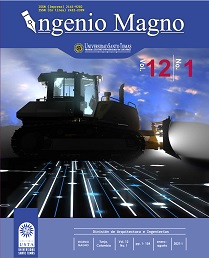Experimental energy performance evaluation in a commercial freezer using R1234yf at different thermal load levels
Main Article Content
Abstract
Downloads
Article Details
DECLARATION OF ORGINIALITY OF SUBMITTED ARTICLE
With this document, I/We certify that the article submitted for possible publication in the institutional journal INGENIO MAGNO of the Research Center Alberto Magno CIIAM of the University Santo Tomás, Tunja campus, is entirely of my(our) own writing, and is a product of my(our) direct intellectual contribution to knowledge.
All data and references to completed publications are duly identified with their respective bibliographical entries and in the citations thus highlighted. If any adjustment or correction is needed, I(we) will contact the journal authorities in advance.
Due to that stated above, I(we) declare that the entirety of the submitted material is in accordance with applicable laws regarding intellectual and industrial property, and therefore, I(we) hold myself(ourselves) responsible for any complaint related to it.
If the submitted article is published, I(we) declare that I(we) fully relinquish publishing rights of the article to the University Santo Tomás, Tunja campus. As remuneration for this relinquishment of rights, I(we) declare my(our) agreement to receive two (2) copies of the edition of the journal in which my(our) article appears.
References
A. Sethi, E. Vera Becerra, and S. Yana Mota, (2016). Low GWP R134a replacements for small refrigeration (plug-in) applications. Int. J. Refrig., 66, 64–72.
A. Mota-Babiloni, J. Navarro-Esbrí, Á. Barragán-Cervera, F. Molés, and B. Peris, (2014). Analysis based on EU Regulation No 517/2014 of new HFC/HFO mixtures as alternatives of high GWP refrigerants in refrigeration and HVAC systems., Int. J. Refrig., 52, 21–31.
U. N. E. P. (UNEP)., “Twenty-Eighth Meeting of the Parties to the Montreal Protocol on Substances that Deplete the Ozone Layer,” in Further Amendment of the Montreal Protocol, (2016).
J. García Pabon, A. Khosravi, J. M. Belman-Flores, L. Machado, and R. Revellin, (2020). Applications of refrigerant R1234yf in heating, air conditioning and refrigeration systems: A decade of researches. Int. J. Refrig., 118, 104–113.
S. Jarall, (2012). Study of refrigeration system with HFO-1234yf as a working fluid. Int. J. Refrig., vol. 35, 1668–1677.
J. M. Belman-Flores, V. H. Rangel-Hernández, S. Usón, and C. Rubio-Maya, (2017). Energy and exergy analysis of R1234yf as drop-in replacement for R134a in a domestic refrigeration system. Energy, 132, 116–125.
Z. Li, K. Liang, and H. Jiang, (2019). Experimental study of R1234yf as a drop-in replacement for R134a in an oil-free refrigeration system. Appl. Therm. Eng., 153, 646–654.
Claudio Zilio, J. Steven Brown, Giovanni Shiochet, Alberto Cavallini (2011). The refrigerant R1234yf in air conditioning systems. Energy, 36, 6110-6120.
Zhaogang Qi (2015). Performance improvement potentials of R1234yf mobile air conditioning system. Int. J. Refrig., 58, 35-40.
H. Cho, H. Lee, Chasik Park, (2012). Performance characteristics of a drop-in system for a mobile air conditioner using refrigerant R1234yf. Korean J. of air condinioning and refrigeration engineering.24, 823-829.
Cleison Henrique de Paula, Wilian Moreira Duarte, Thiago Torres Martins Rocha, Raphael Nunes de Oliveira, Antônio Augusto Torres Maia, (2020). Optimal design and environmental energy and exergy analysis of a vapor compression refrigeration system using R290, R1234yf and R744 as alternatives to replace R134a. Int. J. Refrig., 135, 10-20.
Kyle M. Karber, Omar Abdelaziz, Edward A. Vineyard (2012), Experimental performance of R-1234yf as a drop-in replacement for R-134a in domestic refrigerators, Int. Refrig. Air Cond. Conference, paper 1228.
J. Navarro-Esbrí, J.M. Mendoza-Miranda, A. Mota-Babiloni, A. Barragán-Cervera, J.M. Belman-Flores, (2013), Experimental análisis of R1234yf as a drop-in replacement for R134a in a vapor compression system, Int. J. Refrig. 36, 870-880.
Samuel F. Yana Motta, Elizabeth D. Vera Becerra, Mark W. Spatz, (2010). Analysis of LGWP alternatives for small refrigeration (plugin) applications. Int. Refrig. And Air Cond. Conference, paper 1149.
Zvonimir Jankovic, Jaime Sieres Atienza, José Antonio Martínez Suárez, (2015). Thermodynamic and heat transfer analyses for R1234yf and R1234ze(E) as drop-in replacements for R134a in a small power refrigeration system, Appl. Therm. Eng. 80, 42-54.
J.M. Belman-Flores, A.P. Rodríguez-Muñoz, C. Gutiérrez Pérez-Reguera, A. Mota-Babiloni, (2017), Experimental study of R1234yf as a drop-in replacement for R134a in a domestic refrigerator, Int. J. Refrig., 81, 1-11.
Juan Manuel García Cisneros, (2018). Diseño, construcción e implementación de un sistema de adquisición de datos para un sistema de refrigeración comercial. Tesis de Licenciatura, Universidad de Guanajuato, Salamanca, Guanajuato, México.
G.A. Toloza-Tabares, V. Pérez-García, D. Méndez-Mendez, J.M. Belman-Flores, M.A. Ferrer-Almaraz, (2018). Análisis de la carga óptima en un sistema de refrigeración comercial usando el R1234yf como reemplazo al R134a, XVII Congreso Nacional de Ingeniería Electromecánica y Sistemas, artículo MEC-E-15.

